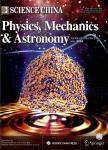Synchrotron peak luminosity,black hole mass and Eddington ratio for SDSS flat-spectrum radio quasars
Synchrotron peak luminosity,black hole mass and Eddington ratio for SDSS flat-spectrum radio quasars作者机构:Key Laboratory for Research in Galaxies and Cosmology Shanghai Astronomical Observatory Chinese Academy of Sciences Shanghai China Graduate University of the Chinese Academy of Sciences Beijing China
出 版 物:《Science China(Physics,Mechanics & Astronomy)》 (中国科学:物理学、力学、天文学(英文版))
年 卷 期:2010年第53卷第S1期
页 面:202-206页
核心收录:
学科分类:07[理学] 070401[理学-天体物理] 0704[理学-天文学] 0702[理学-物理学]
基 金:supported by the National Natural Science Foundation of China (Grant Nos. 10633010,10703009,10833002 and 10821302) the National Basic Research Program of China (Grant No. 2009CB824800)
主 题:black hole physics galaxies:active galaxies:nuclei quasars:emission lines quasars:general
摘 要:For a sample of 185 flat-spectrum radio quasars(FSRQs) constructed from the SDSS DR3 quasar catalog,we found a significant correlation between the synchrotron peak luminosity and both the black hole mass and Eddington *** implies that the physics of its jet formation is not only tightly related with the black hole mass,but also with the accretion *** verify that the synchrotron peak luminosity can be a better indicator of jet emission than 5 GHz luminosity,through comparing the relationships between each of these two parameters and both black hole mass and Eddington *** fundamental plane of black hole activity for our FSRQs is established as Lr ∝ L0x.80 ± 0.06 Mbh -0.04 ± 0.09 with a weak dependence on black hole mass,however,the scatter is significant.



